Онлайн-урок "Ukrainian Traditional Meals" в додатку ZOOM
Урок іноземної (англійської ) мови
Викладач Перерва В.М.,
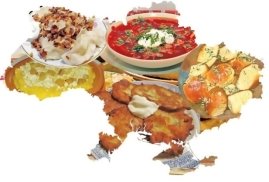 ДНЗ «Професійно-технічне училище № 14 м.Нова Каховка»
ДНЗ «Професійно-технічне училище № 14 м.Нова Каховка»
Тема програми: Харчування
Тема уроку: Українські традиційні страви
Мета: поглибити знання про українські традиційні страви та історію їх походження засобами англійської мови, формувати вміння використовувати набуті знання у майбутній професії, вміння використовувати різноманітні стратегії для задоволення власних іншомовних комунікативних намірів (працювати з підручником, словником, довідковою літературою, мультимедійними засобами), співпрацювати з іншими для досягнення визначеного результату, спілкуючись іноземною мовою; розвивати вміння критично оцінювати інформацію та використовувати її для різних потреб, розуміти на слух зміст автентичних текстів, мовні, інтелектуальні і пізнавальні здібності, готовність брати участь в іншомовному спілкуванні; виховувати в учнів позитивне ставлення до іноземної мови як засобу спілкування та розуміння важливості оволодіння іноземною мовою і потреби користуватися нею як засобом спілкування, гордість за Україну, її мову та культуру, розуміння потреби популяризувати Україну у світі засобами іноземних мов, усвідомлення того, що, вивчаючи іноземну мову, ми збагачуємо рідну, готовність до міжкультурного діалогу.
Тип уроку: розвиток компетентностей
Компетентності:спілкування державною мовою, спілкування іноземною мовою, математична, інформаційно-цифрова, уміння вчитися впродовж життя, ініціативність і підприємливість, соціальна та громадянська компетентності
Методи та прийоми: «Ланцюжки літер», елементи дискусії (робота з висловом відомого кухара), «Хмари слів», читання тексту з маркуванням, складання синквейну, складання карти пам’яті
Обладнання: проектор, ноутбук, мультимедійна презентація, картки для читання, різнорівневі картки для перевірки розуміння прочитаного, ілюстративний матеріал
Хід уроку (урок проводиться у додатку Zoom)
I. Вступна частина (використовується функція «Сесійна зала»»
- Привітання
- Оголошення теми та мети уроку (функція «Демонстрація екрану»)
The theme of today’s lesson is… Actually I would like you help me. You can see at the screen matching words and you should divide them. And only after that we’ll get to know the theme of today’s lesson. (Аби дізнатися тему, потрібно розділити ланцюжок літер на слова)
Ukrainiantraditionalmeals
So the theme is “Ukrainian Traditional Meals”
During the lesson we’ll speak about it, listen some pupil’s projects, write and read. But before starting I want introduce some rules of the lesson (визначення правил уроку):
- Be attentivelyand polite
- Be creative
- Don’t keep the silence and speak clearly
- Listen to the teacher and other students, cooperate with them
- One person talk at a time
- Respect others opinion and don’t interrupt others
-
Respect personal space and rights
- Мовленнєва зарядка (функція «Демонстрація екрану», деякі учні опитуються усно, інші використовують функцію «Коментарі»)
 And now look at the screen and let’s read the words of Gordon James Ramsay. By the way do you know who is it? It is famous British chef.
And now look at the screen and let’s read the words of Gordon James Ramsay. By the way do you know who is it? It is famous British chef.
So once he said:
“A person should know about food no less than about mathematics or native language” (обговорення вислову відомого британського шеф-кухара, діти аргументовано погоджуються або не погоджуються з його словами, )
Do you agree with his statement? Why? Why is it so important to know about food or maybe traditional food? For answering use the next phrases:
I think / I feel/ I guess/ I suppose – я думаю, вважаю
in my view / in my opinion / from my point of view – з моєї точки зору
well, so – ну, отже
really / actually – насправді
thatistosay – так висловитися; atleast – принаймні
Iamafraid – боюся що…, на жаль
Imean – я хочу сказати
II. Основна частина
- Актуалізація опорних компетентностей
1.1 Speaking (функція «Демонстрація екрану» та «Інтерактивна дошка» або «Підняття руки»)
As far as you know our country has a lot of traditional meals. Can you name them?
As for me I like holubtsy or cabbage rolls. They are so delicious because I like cabbage and meat. I always prepare it for my family. By the way my children like it too.
What is your favourite dish? Why? (Говоріння. Коротко розповісти про улюблену українську страву, спираючись на зразок викладача)
- Reading (хмари слів)
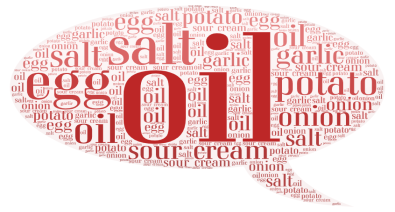 Your task is: read the recipe and guess the dish. (прочитати рецепт і вгадати страву)
Your task is: read the recipe and guess the dish. (прочитати рецепт і вгадати страву)
Відповідь:Борщ, деруни, млинці, голубці,вареники
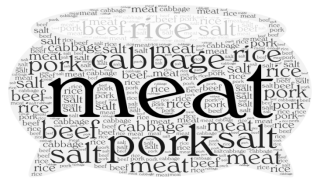
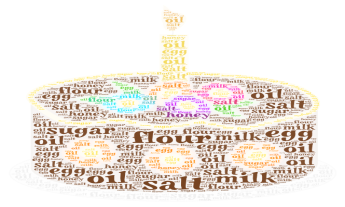
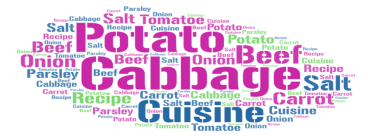
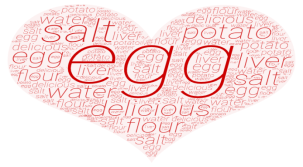
- Формування нових компетентностей. Listening
Pre-listening activity (функція «Інтерактивна дошка»)
Some pupils have prepared for you some information about borsch, I’d like you to listen it and after it you should do some tests. But before we start I’d like you fill in the table:
|
I know(знаю) |
I’d like to know (хочу дізнатися) |
Now I know (тепер я знаю) |
|
|
|
|
Listening
Borsch
Borsch (beetroot soup) is not just a traditional Ukrainian daily meal, it’s a symbol of unity - the basis of the culinary tradition of Ukraine, which is stronger than any modern experiments. Borsch is a dish with a national character. It is primarily associated with Ukraine. This “association” smells delicious and promises warmth, comfort, fullness, and, thus, sense of peace. When Ukrainians choose to cook borsch as their everyday main dish - their express their patriotism and show their love for Ukraine.
In Ukraine, borsch has long been considered a symbol of a strong family: all the ingredients are cooked in a clay pot, transferring their flavors to each other, and as a result become one whole – a rich, hearty, and dense borsch. In days of old, borsch was eaten almost every day, served on holidays and at weddings. The peculiarity of this dish is that it becomes tastier the next day when flavors are well blended together.
A little later, Ukrainians started to add cut salo for a better taste, and Ukrainian Cossacks brought garlic and many different spices. Borsch was cooked with beans, browned flour, millet or buckwheat, and dumplings. On holidays or on Sundays borsch was cooked using a meat broth. On weekdays Ukrainians added salo fried with onions and garlic.
As most Ukrainians had a cow; they dressed the beet soup with sour cream on special days.
Red (classic) borsch
The classic red beet soup always included beet. Fresh pork salo (fat) crushed with garlic, salt, and culinary plants were added to the soup at the end of boiling. Then the pot with borsch was covered with a lid and left for at least half an hour to infuse (the longer the better).
Green (spring) borsch
This soup was boiled with fresh sorrel, nettle, saltbush, and young beetroot leaves. Ukrainians also added boiled eggs, and sour cream or whey. During Lent, the meat was replaced with fish or mushrooms.
Cold (summer) borsch
This soup was cooked on hot summer days. Young beet was boiled, cut into strips and mixed with kvass, and whey or sour cream. Then fresh parsley, dill, spring onion and garlic were added. Boiled eggs were also included. This borsch was served chilled with bread and boiled potato.
In winter Ukrainians often cooked borsch with fish which was beforehand dried on straw in the stove. In spring Ukrainians added sorrel and boiled green borsch. In summer they cooked the cold borsch which is called – “kholodnyk.”
During lent Ukrainians cooked borsch with dried fish and mushrooms.
Though Ukrainian beet soup has several dozens of tasty variations, depending on the region where it is cooked, yet it always and everywhere remains to be borsch.
People who live in the Carpathians add pickled cabbage to their borsch.
In Chernihiv region, Ukrainians cook borsch with “mushroom ears" (dumplings with mushrooms) and call it “Pereiaslavskyi. ”
In Poltavshchyna people boil borsch using chicken broth and always add halushky (lazy dumplings) that are traditional for their region. The residents of Zhytomyr region have two borsch varieties: “poliskyi” – soup with dried loaches and mushrooms and "korostenskyi " – the one cooked with dried fruits. In ancient times, people who lived in Halychyna boiled very thin beet soup using only potato and beet and added a cherry or apple juice for a slightly sour taste.
Ukrainian borsch has long ago become the symbol of the Ukrainian nation in the world, and, what is encouraging, it is a favorite dish of many people, regardless of their nationality.
One of the richest and most popular recipes is the one for “Borsch Kyivskyi”. The main ingredients for this recipe are beef, lamb and pork. Bread kvas is put additionally.
Over the years, this dish has evolved, and today more than 100 recipe variations have appeared.
In any case, every hostess has her recipe for borsch, her secrets of cooking, which are usually passed from generation to generation.
Post-listening activity
So answer the questions (відповісти на питання до прослуханого тексту):
- Borsch is a symbol of what? (unity,strong family )
- In what century potato was added to the borsch? (19)
- Who did bring garlic and many different spices into the borsch? (Ukrainian Cossacks)
- What kind of borsch do you know? (red, green, cold)
- How many recipes of borsch are there in Ukraine? (more then 100)
- Застосування набутих компетентностей (функція «Розділення на кімнати учасників за таймінгом»)
Читання тексту з маркуванням ( текст “Borsch”) Додатки
За картками обговорення та перевірка правильності виконання. Презентація деякими учнями карт пам’яті
- Закріплення компетентностей (функція «Демонстрація екрану»)
4.1. Chain of letters
How many Ukrainian meals can you find in this chain of letters? There are … words there. Can you find them? (знайди українські страви у ланцюжку літер. Завдання ускладнене тим, що у ланцюжку перераховані страви різних народів світу)
pastacabbagerollspampushkipizzapancakesfishandchipsfrenchfriesuzvarryazshenkavarenikihotdogjellycheesesoup
 4.2. Cкладання синквейну
4.2. Cкладання синквейну
Borsch
Traditional, delicious
Eat, proud, to cook
Ukrainian traditional delicious dish
Red soup
ІІІ. Заключна частина
- Підведення підсумку (функції «Підняття руки», «Коментарі»)
Fill in the table:
|
I know |
I’d like to know |
Now I know |
|
|
|
|
So was the lesson useful for you?Will you need knowledge from this lesson in your future job?
- Feedback 5-1. Оцінювання (функції «Підняття руки», «Коментарі»)
Name 5 new words (назви 5 нових слів)
Make up 4 word-combinations with these words (склади 4 словосполучення з цими новими словами)
Name 3 interesting facts you know after the lesson (назви 3 нових цікавих факти для тебе)
Name 2 most active students (назви 2 найактивніших учнів)
Say 1 thing that you liked (назви 1 завдання, яке сподобалось)
Оголошення домашнього завдання
1 кімната: create your own recipe of borsch
2 кімната:Tell about borsch according your mind-map
3 кімната:Write some proverbs about food
Додатки
![]()
Card 1
- Read the text and tick near it when you’ll read about:
A symbol of unity
A national character
Love for Ukraine
A symbol of a strong family
To show love for Ukraine
Old Slavonic word
The symbol of the Ukrainian nation
A favorite dish of many people
- Match the words with their translation:
|
|
|
|
|
|
|
|
|
|
|
|
|
|
|
|
- Make up your own mind-map about borsch in Ukrainian culture using the words-combinations from Ex.I
![]()
![]()
Card 2
Read the text and tick near it when you’ll read about:
Find the true sentences and stick it:
- Borsch is a dish without a national character.
Borsch is a dish with a national character.
Borsch is not a dish with a national character.
- The word borsch originated from the Old British word "b’rshch" (beet).
The word borsch originated from the Old Greece word "b’rshch" (beet).
The word borsch originated from the Old Slavonic word "b’rshch" (beet).
- In days of old, borsch was eaten almost every day, served on holidays and at weddings.
In days of old, borsch was eaten only on holidays and at weddings.
In days of old, borsch was eaten only at the weekends.
- The potato was added from the second half of the 18th century.
The potato was added from the second half of the 19th century.
The potato was added from the second half of the 17th century.
- Ukrainian Cossacks brought garlic and many different spices into the borsch.
Ukrainian famous cook brought garlic and many different spices into the borsch.
Ukrainian woman brought garlic and many different spices into the borsch.
- On weekdays Ukrainians added potato fried with onions and garlic.
On weekdays Ukrainians added salo fried with onions and garlic.
On weekdays Ukrainians added beef fried with onions and garlic.
- Ukrainians dressed the beet soup with sour cream on special days because they have chickens.
Ukrainians they dressed the beet soup with sour cream on special days because they have dairy’s shops.
Ukrainians dressed the beet soup with sour cream on special days because most of them had cows.
![]()
![]()
Card 3
- Read the text and tick near it when you’ll read about:
Red borsch
Green borsch
Cold borsch
Carpathianborsch
Pereiaslavskyiborsch
Poliskyiborsch
Korostenskyiborsch
Kyivskyiborsch
- Read the text and make up your own mind-map about kinds and types of borsch and their recipes.
![]()
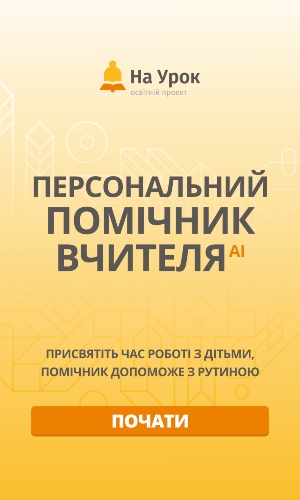

про публікацію авторської розробки
Додати розробку
